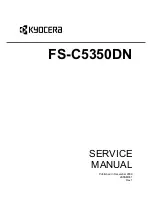
7-84
SYSTEM SETTINGS
Contents
Security Settings
The following settings are related to security. Touch the [Security Settings] key to configure the settings.
SSL Settings
SSL can be used for data transmission over a network.
SSL is a protocol that enables the encryption of
information communicated over a network. Encrypting
data makes it possible to transmit and receive sensitive
information safely.
SSL can be enabled for the following protocols:
Server Port
• HTTPS: Apply SSL encryption to HTTP
communication.
• IPP-SSL: Apply SSL encryption to IPP
communication.
• Redirect HTTP to HTTPS in Device Web Page
Access:
When this setting is enabled, all communication that
attempts to access the machine by HTTP is redirected
to HTTPS.
Client Port
• HTTPS:
Apply SSL encryption to HTTP
communication.
• FTPS:
Apply SSL encryption to FTP
communication.
• SMTP-SSL: Apply SSL encryption to SMTP
communication.
• POP3-SSL: Apply SSL encryption to POP3
communication.
• LDAP-SSL: Apply SSL encryption to LDAP
communication.
Level of Encryption
The encryption strength can be set to one of three levels.
IPsec Settings
IPsec can be used for data transmission/reception on a
network. When IPsec is used, data can be sent and
received safely without the need to configure settings for
IP packet encryption in a Web browser or other
higher-level application.
This setting is only used to enable or disable IPsec;
detailed IPsec settings are configured in the Web pages.
Note the following points when enabling IPsec:
• A certain amount of time may be needed for the
setting to be updated. During this time, it will not be
possible to connect to the machine.
• If the settings in the Web page are not configured
correctly, it will not be possible to connect to the
machine, and printing, scanning, and Web page
display may not be possible. In this event, disable the
setting at the machine and then correct the settings in
the Web page.
IEEE802.1X Setting
IEEE802.1X can be used to authenticate a user to allow
use of the machine.
IEEE802.1X protocol defines port-based authentication
for both wired and wireless networks.
Use IEEE802.1X authentication to allow only
authenticated devices to use network, and protect
against network abuse by third parties.
This setting is only used to enable or disable
IEEE802.1X; detailed IEEE802.1X settings are
configured in the Web pages.
Some Web page settings may not allow connection to
the machine, or the settings may not allow printing,
scanning, or Web page display. In this case, deselect
this setting and change the Web page settings.
Detailed IPsec settings are configured in [IKEv1
Settings] and [IPsec Rules] in [Security Settings] >
[IPsec Settings] in the Web page menu.
Advanced IEEE802.1X settings are configured by
clicking [Security Settings] and then [IEEE802.1X
Settings] in the Web page menu.
Summary of Contents for MX-B401
Page 4: ...Reduce copy mistakes Print one set of copies for proofing ...
Page 6: ...Make a copy on this type of paper Envelopes and other special media Transparency film ...
Page 11: ...Conserve Print on both sides of the paper Print multiple pages on one side of the paper ...
Page 35: ...Organize my files Delete a file Delete all files Periodically delete files Change the folder ...
Page 203: ...3 18 PRINTER Contents 4 Click the Print button Printing begins ...
Page 835: ......
Page 836: ......
















































